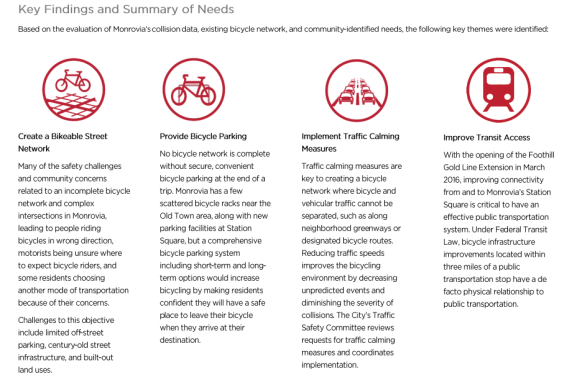The San Gabriel Valley city of Monrovia may soon have an extensive network of bikeways offering residents and visitors safer streets connecting to many key destinations. Monrovia is expected to approve its new Bicycle Master Plan next month.

Following recent unanimous planning commission approval, Monrovia's long awaited bike plan will reach city council for expected approval on July 5.

The final draft of the Monrovia bike plan aims to build a safe and interconnected bicycle transportation network. This will encourage active transportation, healthier lifestyles, and more-accessible connections to public transit options for the largely car-dependent 14-square mile San Gabriel Valley city.
The plan serves as a framework for future potential policies, infrastructure improvements, and programming opportunities all in the service of safe and inclusive bicycle infrastructure.

If approved, the plan will be integrated within Monrovia’s Capital Improvement Projects and provide opportunities for county-Metro, state, federal, and non-profit funding from numerous active transportation grant opportunities. Some of the planned projects include the implementation of a bicycle wayfinding signage network, bicycle safety education programs, bicycle parking, and, of course, a variety of bikeways, including paths, protected and unprotected bicycle lanes, and bike routes. The plan recommends further feasibility studies for protected bike lanes on portions of Duarte Road, Foothill Boulevard, Huntington Drive, Mayflower Avenue, Myrtle Avenue and Peck Road.
The initiative to create a bicycle master plan arose when city officials and Move Monrovia, a residents' advocacy group, joined forces to expand transportation infrastructure for easier and safer access to the city's Metro Gold Line rail station, which opened in March.

Spurred by the initial success of the station redesign, the Move Monrovia efforts grew to help the city develop a master bike plan to conveniently coincide with Monrovia Renewal, an already-approved $51.7 million plan to refurbish and repair existing city streets, sidewalks, and water infrastructure. Monrovia Renewal represents a huge opportunity to integrate approved bicycle projects in street repairs and renovations.
In a phone interview, Nancy Bond of Move Monrovia noted the importance of persistent cooperation between activists, local community members, and government officials in the formation of the bicycle plan:
It’s important to make friends with government agencies, leaders, and officials. Listen to them and find out what it is what they want. Don’t force an agenda; rather see if you can work together. Street safety is a universal concern.
Bond also emphasized the bicycle education directives noted in the plan.

One of the sad things we found was that the majority of the [bicycle] accidents were involving people who perhaps don’t drive cars. Without knowing the rules of the road, sometimes they will ride on the wrong side of the street after dark with no lights. So I think one of the biggest goals of this plan is the educational component. We talked about connecting schools with bike education and holding local community adult safety classes.
The Monrovia Bicycle Master Plan details potential safety initiatives in addition to the multi-faceted potential advantages of a robust city bicycle network plan. Benefits range from reduced bicycle and car collisions, improved traffic calming, encouragement of healthier and active lifestyles, and a more livable and sustainable city. All this indicates that bicycle-friendly infrastructure and policies are not limited to just denser, urban centers, but can improve the quality of life in smaller cities.

The plan’s formation also aligns with Metro’s bike-share feasibility studies of L.A. county cities. Community members and city leaders alike have expressed interest in a regional, inter-city bike-share network. In recent years, numerous San Gabriel Valley cities have come together to draft and approve regional, inter-city bicycle plans. Soon Monrovia will likely join these other San Gabriel Valley livability leaders.
If SBLA readers are interested in supporting safer streets in Monrovia, make plans to attend the City Council meeting on Tuesday July 5.
SBLA coverage of San Gabriel Valley livability is supported by Foothill Transit. Foothill Transit has been a leader in sustainable transportation for years. And now they’re committed to having a 100% electric bus fleet by 2030. To celebrate, Foothill Transit is giving away prizes and sharing facts about how their electric buses help clear the air. Visit Foothill Transit’s e-bus sweepstakes webpage to see how you can join in the eco-friendly fun!






